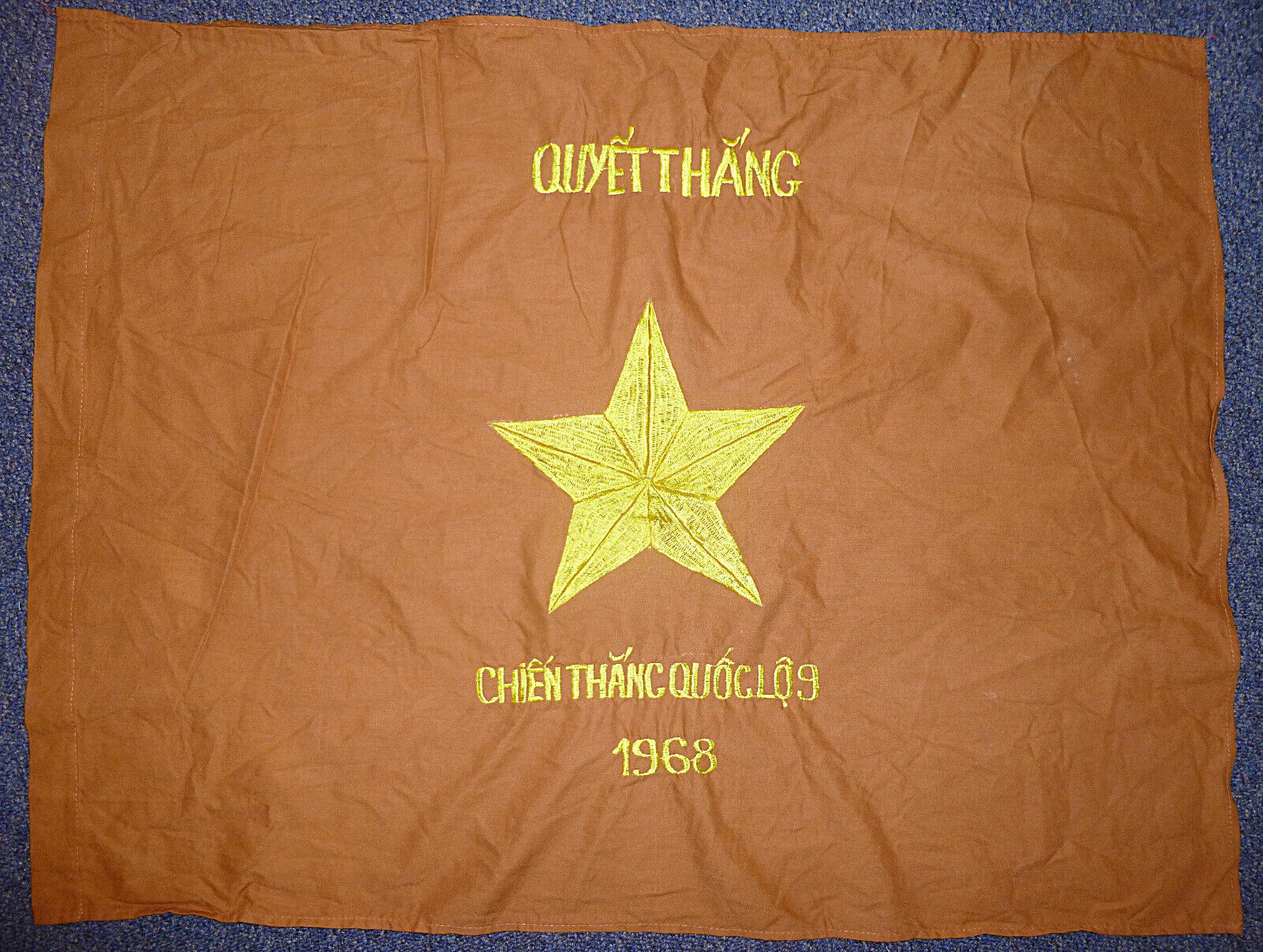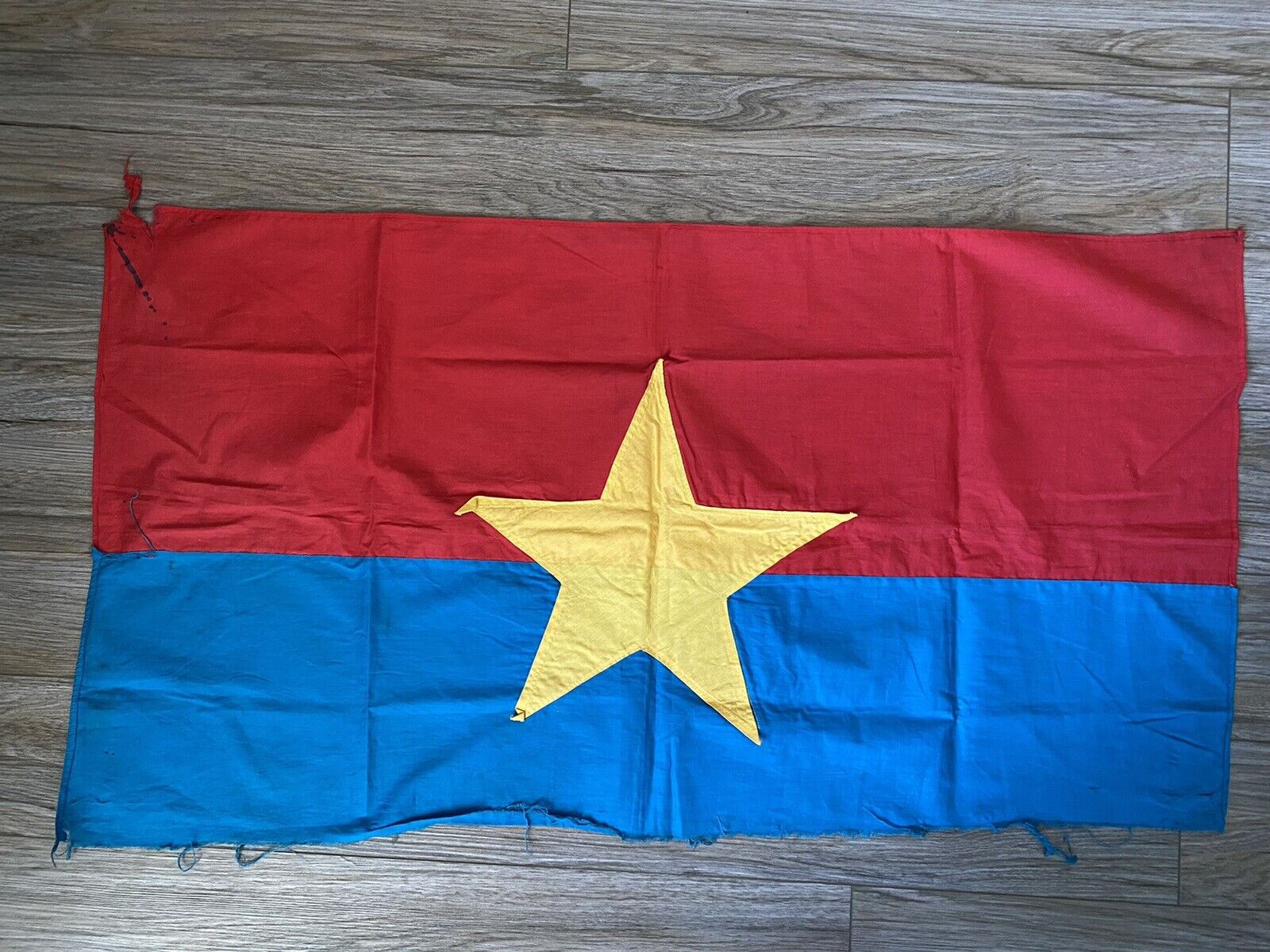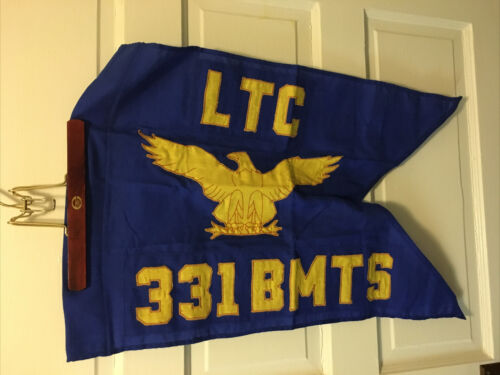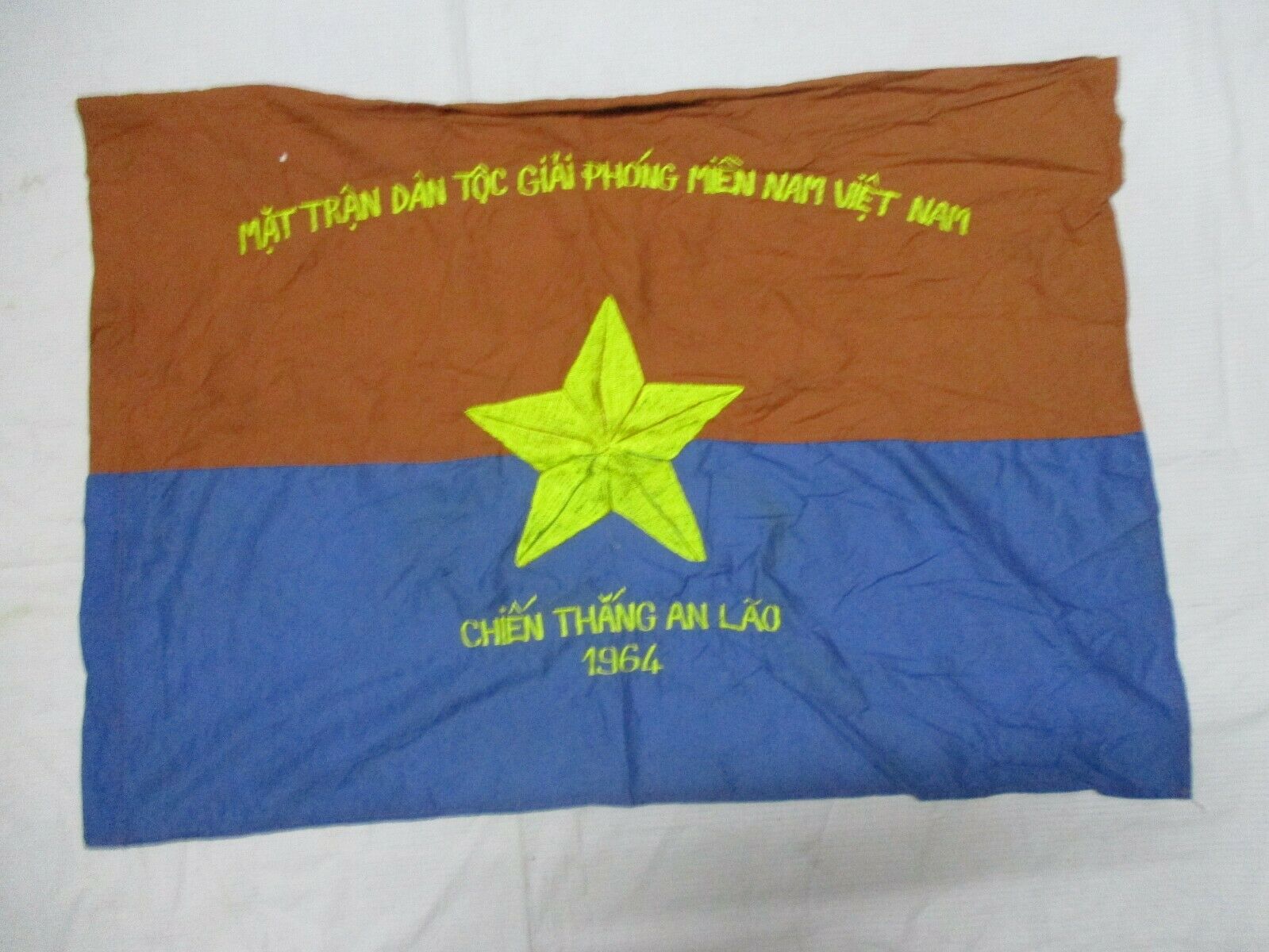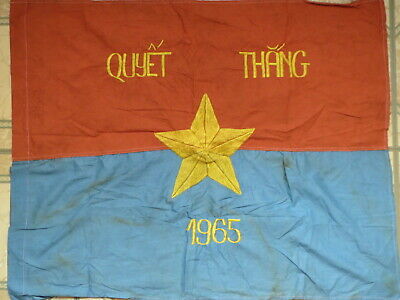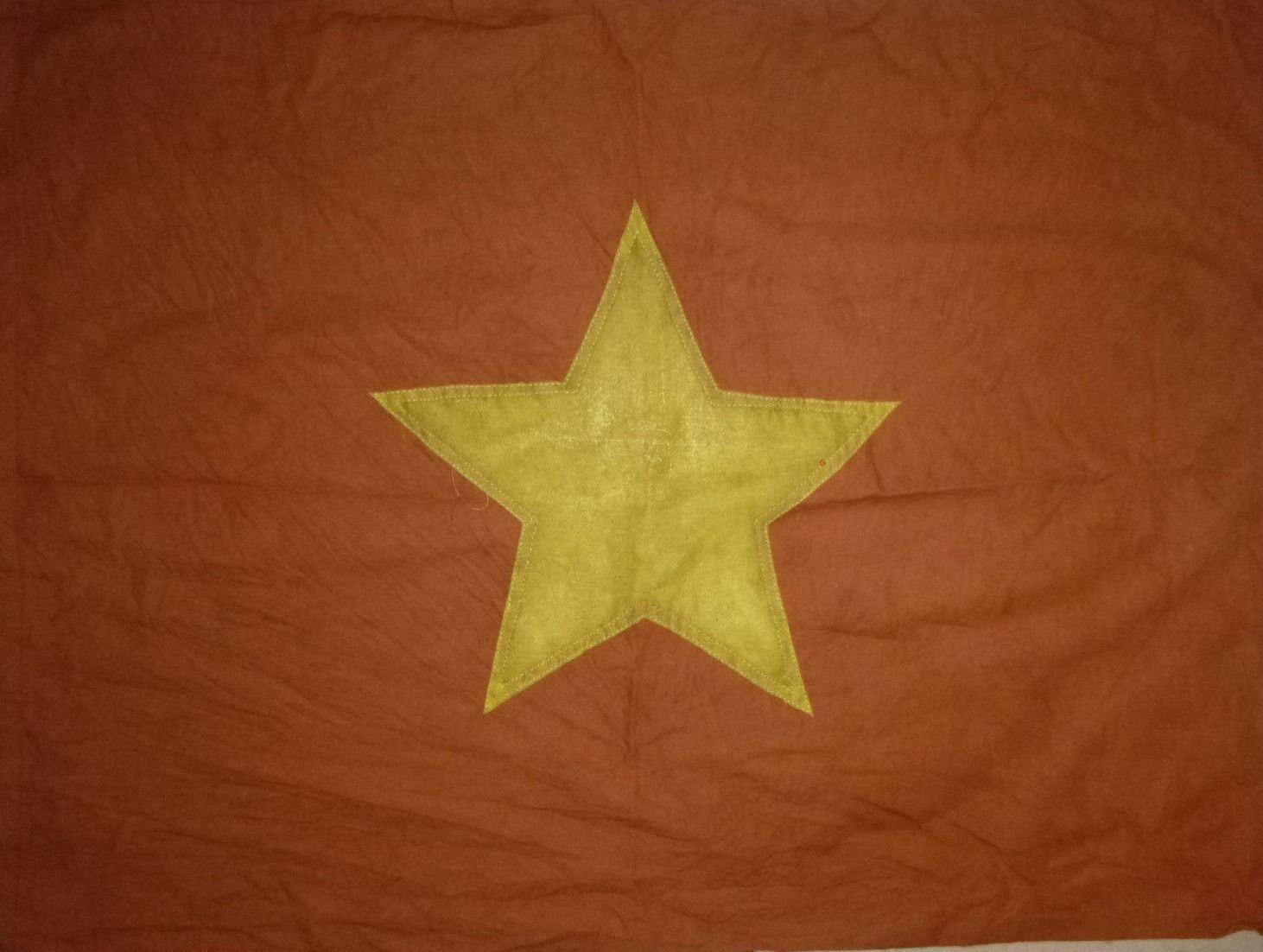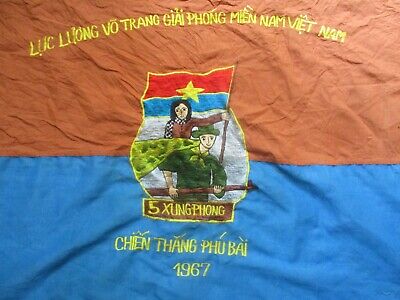-40%
Highway 9 - Siege of Khe Sanh - NLF Viet Cong Flag - TET 1968 - Vietnam War - F0
$ 43.55
- Description
- Size Guide
Description
Viet Cong Battle Flag - Car Flag - Viet CongNational Front for the Liberation of South Vietnam - Car Flag - House Flag - Battle Flag
NLF - Communist Army of South Vietnam - NLF - VC
Excellent War Piece - Original - Excellent Condition
Chiến Thắng Quốc Lộ 9 - 1968 - Victory Highway 9 - 1968
Measures - 29 x 21 inches (75 x 54 cms)
Excellent Piece
NLF, NVA, VC - Viet Cong / National Liberation Front
Battle of Khe Sanh – Siege of Khe Sanh.
The Battle of Khe Sanh (21 January – 9 July 1968) was conducted in the Khe Sanh area of northwestern Quảng Trị Province, Republic of Vietnam (South Vietnam), during the Vietnam War.
The main US forces defending Khe Sanh Combat Base (KSCB) were two regiments of US Marines supported by elements from the United States Army, US Special Forces, and the United States Air Force.
There were also a small number of South Vietnamese Army (ARVN) troops. These were pitted against two to three divisional-size elements of the North Vietnamese Army.
MACV command in Saigon initially believed that combat operations around Khe Sanh Combat Base during and in late 1967 were part of a series of minor North Vietnamese offensives in the border regions.
That appraisal was later altered when it was discovered that the NVA was moving major forces into the area.
In response, US forces were built up before the NVA isolated the Marine base.
Once the base came under siege a series of actions were fought over a period of five months. During this time, Khe Sanh and the hilltop outposts around it were subjected to constant North Vietnamese artillery, mortar, and rocket attacks, and several infantry assaults.
To support the Marine base, a massive aerial bombardment campaign (Operation Niagara) was launched by the United States Air Force.
Over 100,000 tons of bombs were dropped by US aircraft and over 158,000 artillery rounds were fired in defense of the base.
In March 1968, an overland relief expedition (Operation Pegasus) was launched by a combined Marine–Army/South Vietnamese task force that eventually broke through to the Marines at Khe Sanh.
In the aftermath, the North Vietnamese proclaimed a victory at Khe Sanh, while US forces claimed that they had withdrawn as the base was no longer required. Historians have observed that the Battle of Khe Sanh may have distracted American and South Vietnamese attention from the buildup of Viet Cong forces in the south before the early 1968 Tet Offensive.
Nevertheless, the US commander during the battle, General William Westmoreland, maintained that the true intention of Tet was to distract forces from Khe Sanh.
It should also be noted that although US Forces moved out of the main base at Khe Sanh after the Tet Offensive, the surrounding area was still under US Control to the extent that Khe Sanh wasre-opened for use by US Forces on numerous occasions. The latest re-opening was for use as a Forward Operating Base, Dustoff Medevac and MASH base in the Lam Son Operations (US invasion of Laos 1970 – 1972).
30th of January 1968 – First Night of the Tet Offensive
Whether by accident or design, the first wave of attacks began shortly after midnight on 30 January as all five provincial capitals in II Corps and Da Nang, in I Corps, were attacked.
Nha Trang, headquarters of the U.S. I Field Force (FFI), was the first to be hit, followed shortly by Ban Mê Thuột, Kon Tum, Hội An, Tuy Hòa, Da Nang, Qui Nhơn, and Pleiku.
During all of these operations, the Viet Cong and North Vietnamese followed a similar pattern: mortar or rocket attacks were closely followed by massed ground assaults conducted by battalion-strength elements of the Viet Cong, sometimes supported by North Vietnamese regulars.
These forces would join with local cadres who served as guides to lead the regulars to the most senior South Vietnamese headquarters and the radio station.
The operations, however, were not well coordinated at the local level.
By daylight, almost all communist forces had been driven from their objectives.
General Phillip B. Davidson, the new MACV chief of intelligence, notified Westmoreland that "
This is going to happen in the rest of the country tonight and tomorrow morning."
All U.S. forces were placed on maximum alert and similar orders were issued to all ARVN units. The allies, however, still responded without any real sense of urgency. Orders cancelling leaves either came too late or were disregarded.
NLF - National Liberation Front
The Việt Cộng, also known as the National Liberation Front (NLF), was a communist political organization with its own army – the People's Liberation Armed Forces of South Vietnam (PLAF) – in South Vietnam and Cambodia that fought the United States and South Vietnamese governments, eventually emerging on the winning side
It had both guerrilla and regular army units, as well as a network of cadres who organized peasants in the territory it controlled. Many soldiers were recruited in South Vietnam, but others were attached to the People's Army of Vietnam (PAVN), the regular North Vietnamese army.
During the war, communists and anti-war activists insisted the Việt Cộng was an insurgency indigenous to the South, while the U.S. and South Vietnamese governments portrayed the group as a tool of Hanoi. Although the terminology distinguishes northerners from the southerners, communist forces were under a single command structure set up in 1958.
North Vietnam established the National Liberation Front on December 20, 1960, to grow insurgency in the South. Many of the Việt Cộng's core members were volunteer "regroupees", southern Việt Minh who had resettled in the North after the Geneva Accord (1954).
Hanoi gave the regroupees military training and sent them back to the South along the Ho Chi Minh trail in the early 1960s.
The NLF called for southern Vietnamese to "overthrow the camouflaged colonial regime of the American imperialists" and to make "efforts toward the peaceful unification".
The People's Liberation Armed Forces of South Vietnam (PLAF)'s best-known action was the Tet Offensive, a massive assault on more than 100 South Vietnamese urban centers in 1968, including an attack on the U.S. embassy in Saigon.
The offensive riveted the attention of the world's media for weeks, but also overextended the Việt Cộng. Later communist offensives were conducted predominantly by the North Vietnamese. The organization was dissolved in 1976 when North and South Vietnam were officially unified under a communist government.
For your kind Consideration.
Free Post over 0 For All Single or Combined Auction or Buy It Now Purchases in same order
,
Command Control, North, South, Central, MACV, Special Forces, SOG, Special Op’s, Special Operations Group, 5 th Special Forces, Army Security Agency, Military Intelligence, Psy-Ops, US Army, De Oppresso Liber, Airborne, 1 st Special Forces, CIDG, Mike Force, Mobile Guerrilla Force, Mobile Strike Force, Operations Detachment, Provincial Recon Unit, Recon Teams, RT, USMC, United States Marine Corps, Vietnam War, WWII, WWI, French Indochine War, French Foreign Legion, Legion Etrange, Project Omega, Recondo School, Rapid Fire, Project Delta, Special Missions Advisory Force, Project Gamma, Project Sigma, Indigenous Troops, MACV-SOG, CCC, CCS, CCN, USARV, SMAG, TAG, Field Training Command, Recon Team Leader, US Navy, Air Force, AATTV, Long Tan, Nui Dat, AAFV, ATF, New Zealand V Force, Big Red One, 1st Infantry Division, 1st Cavalry Division, Tropic Lightning, 25th Infantry Division, Subdued, Patch, Patches, Uniform, Helmet, Flash, Beret, Arc, Tab, 101 st Airborne Division, 82nd Airborne, 173rd Airborne, Combat, Militaria, Medal, Badge, Map, 199th Infantry Brigade, Old Ironsides, 5th Infantry Division, MAAG, USARPAC, XXIV Corps, 23rd Infantry Division, Americal, 38th Infantry Division, Black Op’s, Clandestine, Non-Conventional Warfare, 11th Infantry Brigade, 11th Armored, 196th , 1st Aviation, 18th Engineers, Medic, Medical, Viet Cong, VC, Viet Minh, Dien Bien Phu, Saigon, Tiger Force Rangers, Ranger, Logistical Command, Khe Sanh, POW, RVN, ARVN, South Vietnam, North Vietnam, NVA, Hanoi, Siagon, Phan Rang, LLDB, Bright Light, Free World Forces, Company, Platoon, Patrol, Long Range, Special Forces, ARVN, Green Berets, Elite, Recon, Reconnaiance, CCN, CCC, CCS, MACV SOG, SOA, Paratrooper, Parachutist, Vietnam War, Special Operations, Military, Tiger, Ranger, Route, Team, VC, NVA, Viet Cong, Command Control
